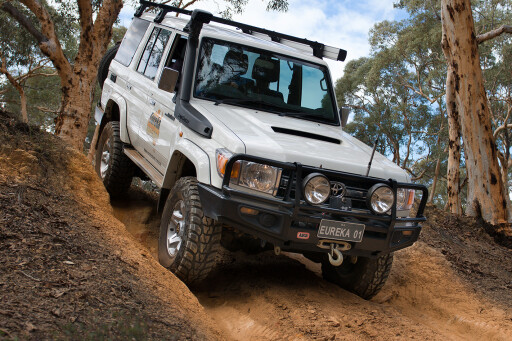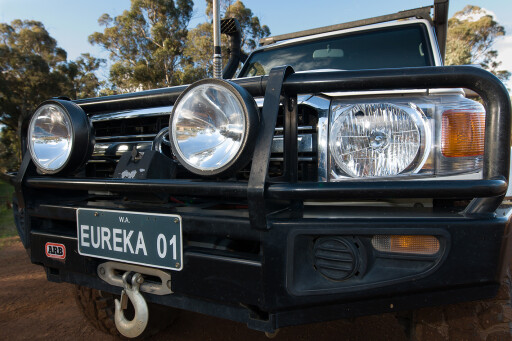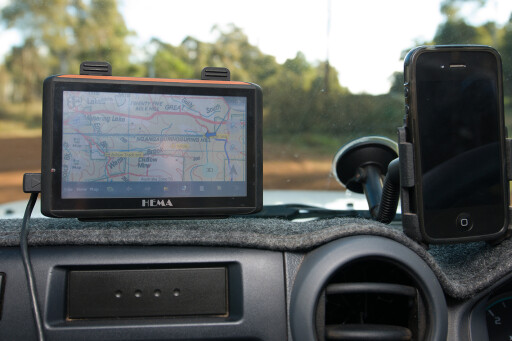.jpg )
WHEN it comes to being serious about four-wheel driving, you can’t go past Mark Haffenden.
This was first published in 4x4 Australia's October 2012 issue.
He lives and breathes it every day. Mark was so enthusiastic about combining his hobby with his day job that he bought well-established Perth training business, Eureka 4WD Training. He loves that he gets paid to pass on his passion to people just starting out on their own personal 4X4 adventure.
 Mark has always owned a 4X4. He started out in the UK 25 years ago with the traditional, no-frills, working man’s chariot of choice, the Landie. In testament to their toughness, it was an original 1948 model that he picked up for the tidy sum of £500.
Mark has always owned a 4X4. He started out in the UK 25 years ago with the traditional, no-frills, working man’s chariot of choice, the Landie. In testament to their toughness, it was an original 1948 model that he picked up for the tidy sum of £500.
That old Landie allowed Mark the enriching experience of spending all his free time scouring the British mainland in search of parts. While Mark’s mates were chatting to the girls, he was heading down to Shropshire for spares.
Land Cruiser Heritage Museum: World’s best Cruiser collection
After battling around the country to every dealer to get his brakes working he sold the Landie with relief to a collector, who kindly took it off his hands for £2000. After his initial glee at turning such a tidy profit, 21-year-old Mark found out he’d been driving a very rare vehicle and could have held out for £10,000.
In the UK, for Mark the emphasis was having a big tough rig to tow a heavy boat and making sure that you could beat the mud suction on dubious boat ramps. Moving out to Australia he realised it definitely was the lucky country – where you could use a 4X4 for touring holidays, weekend recreation, fishing trips and camping.
 Within six months, Mark was gearing up a 1985 70 Series LandCruiser ute. After a few years he switched to a 1989 SR5 HiLux, and then moved into a Holden Jackaroo. Some might think that an unusual choice given his previous vehicles, but Mark was adamant, saying: “The Jackaroo is one of the most under-rated four-wheel drives ever.
Within six months, Mark was gearing up a 1985 70 Series LandCruiser ute. After a few years he switched to a 1989 SR5 HiLux, and then moved into a Holden Jackaroo. Some might think that an unusual choice given his previous vehicles, but Mark was adamant, saying: “The Jackaroo is one of the most under-rated four-wheel drives ever.
That Jackaroo got me everywhere I needed to go and in comfort. Fantastic vehicle.” You see, that’s the key: a vehicle’s real value is its ability to meet your individual requirements and effectively execute the tasks you need done safely and reliably.
Mark now has an awesomely kitted-out 2010 76 Series LandCruiser wagon as the perfect work bus for his training duties and serious off-road adventuring. His first thought was to buy a 200 Series, but the 76 was more practical for training and having lived with it for a couple of years, Mark wouldn’t swap, even if he had the opportunity, as he’s found it to be a very capable vehicle.
Mark likes the 76’s squared-off solid shape and style. While not as plush as a 200, the 76 Series isn’t pretentious when it comes to an honest balance between comfort, practicality and functional capability. In Mark’s opinion, the Cruiser’s V8 is its best feature as it provides an excellent combination of power and torque.
.jpg ) He scratched his head a little about the lack of standardisation of the wheel track front to rear, but the V8 manages to overcome the extra drag in the sand. While he was in re-design mode, Mark reckoned that a sixth gear would be a brilliant addition.
He scratched his head a little about the lack of standardisation of the wheel track front to rear, but the V8 manages to overcome the extra drag in the sand. While he was in re-design mode, Mark reckoned that a sixth gear would be a brilliant addition.
The 76 Series could certainly do with a taller overdrive, because the big V8 doesn’t need to spin that hard to maintain legal cruising speed as easily demonstrated in the 200. For good reason Mark’s kept the driveline standard Tojo.
He optioned up the 76 with a set of factory-fitted twin diff-locks to ensure he can squeeze every last Newton-metre from that lusty V8 to keep the wheels driving in the heaviest terrain going, even if only one wheel has any traction. Not a cheap option out of the factory, but Mark insists that they’re worth every cent as his most important ‘can’t live without’ accessory.
“Fitting later allows you to spread the budget pain but quality aftermarket options are a similar cost so for my requirements ordering out of the factory avoids any possibility of warranty disagreements or discussions over the usage of non-OEM components,” he says.
 A black powder-coated winch-compatible ARB bullbar and the standard Toyota factory snorkel were additional dealer-delivered options that saved time and sped up the custom fit-out. The bar provides a home for a neat set of Nane HID spotlights. Also hanging off the bar is a Tiger 12,000lb remote-control winch and UHF aerial.
A black powder-coated winch-compatible ARB bullbar and the standard Toyota factory snorkel were additional dealer-delivered options that saved time and sped up the custom fit-out. The bar provides a home for a neat set of Nane HID spotlights. Also hanging off the bar is a Tiger 12,000lb remote-control winch and UHF aerial.
As the training courses encourage students to get bogged in order to teach them safe recovery techniques, the Tiger winch and properly rated chassis-mounted recovery points regularly prove their worth. Mark always does his research and listens to the professional fitters to avoid too much changing around on his vehicles.
Andrew Fardon of Off Road Equipment, in Perth, has fitted most of the gear on the 76 over the past couple of years. Mark believes the best option is to make a sensible choice up-front and avoid the pain and cost of fitting and removing accessories that are only suited to extreme and rarely-encountered conditions.
Mark’s been very pleased with the performance of his Bluemax two-inch lift kit. While the name may not be the first to come to mind when thinking branded aftermarket suspension, Bluemax has been around for some time. Their staff have many years experience in commercial, heavy-haulage applications.

With an already well-positioned underbody driveline layout, twin diff-locks and those couple of extra inches of clearance, Mark’s yet to find a situation he can’t successfully negotiate using the correct technique and commonsense. Mark reckons the standard factory rims look great and his only gripe is that the replacement cost is controlled by Toyota.
He’s upgraded the rubber and is running Kumho 285/75/16 mud tyres for the winter. Given the 76 Series was never considered a benchmark for interior noise suppression, we were impressed that the muddies didn’t seem overly intrusive in the cabin. Any extra noise was negligible and was well worth the aggressive grip in the sloppy stuff.
To ensure maximum travel distance in remote locations a Brown Davis long-range tank is neatly tucked under the rear of the 76 to provide a usable 170-litre capacity when combined with the main 90-litre tank.
.jpg ) A Kaymar dual-wheel carrier relocates the original spare and enables the security in numbers of adding a second spare – plus provides a handy location for a Howling Moon rear rubbish carrier. A solid, heavy-duty Hayman Reese hitch reliably handles any towing requirements.
A Kaymar dual-wheel carrier relocates the original spare and enables the security in numbers of adding a second spare – plus provides a handy location for a Howling Moon rear rubbish carrier. A solid, heavy-duty Hayman Reese hitch reliably handles any towing requirements.
There’s a Rhino roof-rack to keep extra gear strapped down up top. A Howling Moon awning provides fast one-man set-up for shade when you pull over for a cuppa and some lunch. Checking out the interior, it’s easy to see that Mark’s priorities are comfort, safety and security.
The biggest criticism of the standard vehicle that Mark had, is that the seat is too close to the dash – he’s looking at getting it modified to let himself stretch out and get comfortable on a long drive. Given he’s got a build similar to John Wayne, who’s going to argue?
With comfortable touring obviously a priority, it’s not a real surprise to find that his favourite accessory “without a shadow of a doubt” was the cruise control.
.jpg ) It won’t keep him out of trouble in the rough stuff as the lockers will, but it will make the tedious journey there and back on the blacktop more relaxing knowing the chance of ‘speed creep’, leading to impromptu donations to the police fund, will be kept in check.
It won’t keep him out of trouble in the rough stuff as the lockers will, but it will make the tedious journey there and back on the blacktop more relaxing knowing the chance of ‘speed creep’, leading to impromptu donations to the police fund, will be kept in check.
While he didn’t describe it as his favourite addition, he’s very fond of his Frontrunner aftermarket centre console. The factory console is very low and provides no place to rest an elbow. The Frontrunner adds the perfect height, and bolts easily onto the factory unit.
It provides nifty hidey-holes, including an inbuilt key-locked safe for extra security. Being rather fond of music, Mark has invested in a Pioneer Mixtrax deck running through a Blaupunkt subwoofer with a Pioneer GMD9500F four-channel amplifier pushing out to six 300W speakers.
In light of all that power-sapping aural stimulus, the Piranha dual-battery system is obviously regarded as a very important addition to the vehicle. Additional entertainment or catching up with the outside world is made possible by running a TV through an 800W inverter.
.jpg ) There are two sets of twin 12V power outlets mounted front and rear so other portable devices can be plugged in.
There are two sets of twin 12V power outlets mounted front and rear so other portable devices can be plugged in.
Mark’s also very pleased with the Outback drawers recently installed by the lads at OL Jandakot – one of the few items that have been replaced on the vehicle as the first set were out of his HiLux and, while perfectly practical in a ute, the old drawers rattled like a cage full of monkeys when located in the cabin.
Mark was very firm about the importance of communications when travelling. In addition to a GME TX3420 remote-head UHF he has a GME High Frequency specifically for remote travel that will be mounted into a soon to be fitted ARB roof console.
When in the vehicle, Mark runs OziExplorer on a nine-inch touchscreen and carries a notebook for mapping out his trips. While a well set-up, well-maintained vehicle allows Mark to travel by himself, he enjoys travelling with a group for company and the chance of a good laugh with his mates.
.jpg ) Mark always carries a satphone in any remote location and has experienced the value of carrying his Hema when heading off for an exploratory bushwalk.
Mark always carries a satphone in any remote location and has experienced the value of carrying his Hema when heading off for an exploratory bushwalk.
With his instincts telling him to head back to camp completely the wrong way, the GPS saved him a long walk and those mates back at camp would have been especially important if he’d continued to ignore his GPS.
Once he was safely back at camp, we reckon his mates must have given him a right royal ribbing when he told them of his misadventures, no doubt enjoying a pretty good laugh at his expense. Mark loves Karijini National Park and names it as his ultimate, all-time favourite destination.
Having covered almost everywhere in WA and toured extensively throughout Australia, he reckons he can’t go past Karijini as being not just incredibly and indescribably beautiful, but amazingly spiritual – even for those who wouldn’t normally think in terms of mysticism or religious experience.
 Upon leaving, he and his mate were surprised to admit that they were saddened to be heading out of the park in a way that was more than just that ‘it was a lovely place to visit, shame our holiday is over’ kind of way.
Upon leaving, he and his mate were surprised to admit that they were saddened to be heading out of the park in a way that was more than just that ‘it was a lovely place to visit, shame our holiday is over’ kind of way.
Other favourites include the Great Victoria Desert, Kennedy Ranges, Steep Point, the Kimberley, Bungle Bungles, plus heading north to the Dampier Archipelago and to the islands off the WA coast.
Mark also loves that the north west offers such a variety of experience: after a surfeit of natural beauty head over to Tom Price and check out the mechanics of locomotives pulling 250 ore-laden carriages across to the ports. The next two destinations he’d like to tick off his list are WA’s Gibb River Road and El Questro.
While Mark has a desk in a standard office building, we could tell he’s delighted that his real office is deep in the heart of the Australian bush – a workplace we’d all love to visit more.

COMMENTS